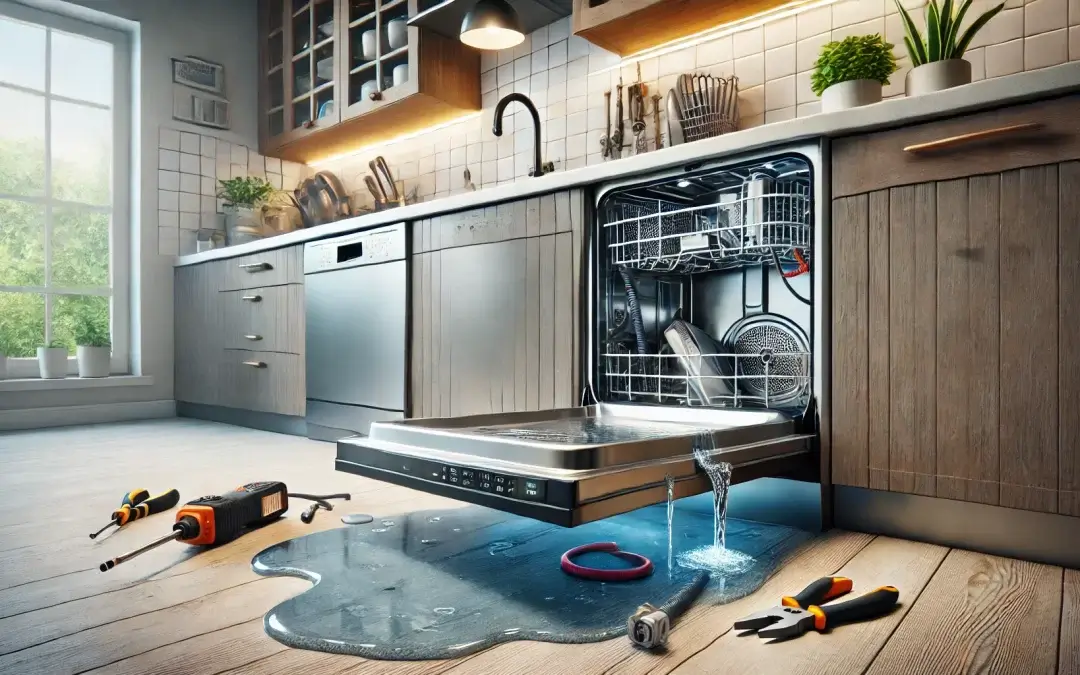Table of Contents
- 1. Identifying the Source of the Leak
- 2. Check the Door Seal for Damage
- 3. Examine the Dishwasher Door Latch
- 4. Inspect the Water Inlet Valve
- 5. Check for Leaks in Hoses and Connections
- 6. Look at the Dishwasher Tub for Cracks
- 7. Evaluate the Float and Float Switch
- 8. Clean the Dishwasher Filter and Drain
- 9. Ensure Proper Leveling of the Dishwasher
- 10. Address Issues with the Spray Arm
- 11. Test the Dishwasher After Repairs
- 12. When to Call a Professional
- 13. Preventive Maintenance Tips
- Conclusion
1. Identifying the Source of the Leak
Before diving into specific fixes, the first step in repairing a leaky dishwasher is identifying the source of the leak. Common areas where leaks occur include the door seal, water inlet valve, hoses, and the tub.
Inspect the dishwasher’s interior and exterior to find where the water is coming from. Place a paper towel or a dry cloth under different areas to pinpoint the source more accurately. Once identified, you can move on to fixing the specific issue.
2. Check the Door Seal for Damage
The door seal, also known as the gasket, is a rubber or vinyl strip that runs along the edge of the dishwasher door. This seal prevents water from seeping out during a wash cycle. Over time, the gasket can become brittle, cracked, or damaged, leading to leaks.
Solution: Inspect the door seal closely for any visible cracks, tears, or wear. If the seal appears damaged, it needs to be replaced. Purchase a replacement gasket designed for your dishwasher model. Remove the old gasket by gently pulling it out, and install the new one by pressing it firmly into the groove around the door.
3. Examine the Dishwasher Door Latch
A dishwasher door latch that doesn’t close properly can cause the door to remain slightly ajar, allowing water to leak out during a cycle. This can be due to a misaligned latch, wear and tear, or a broken latch mechanism.
Solution: Open and close the dishwasher door to check if the latch is catching properly. If it feels loose or doesn’t lock tightly, try tightening the latch screws. If the latch is broken, order a new latch specific to your dishwasher model and follow the manufacturer’s instructions to install it.
4. Inspect the Water Inlet Valve
The water inlet valve controls the flow of water into the dishwasher. A malfunctioning valve can either let too much water in, causing overflow, or let water trickle into the machine when it’s off, leading to leaks.
Solution: Disconnect the dishwasher from the power supply and turn off the water supply. Remove the access panel at the bottom of the dishwasher to locate the water inlet valve. Check for any visible damage or loose connections. If the valve appears faulty, replace it with a new one that matches your dishwasher model.
5. Check for Leaks in Hoses and Connections
Dishwashers have multiple hoses that connect to water supplies and drain lines. Over time, these hoses can become loose, cracked, or worn, causing water to leak out.
Solution: Examine all hoses connected to your dishwasher for signs of wear or leaks. Tighten any loose connections and replace any damaged hoses. When replacing, ensure that the new hoses are secured tightly and free from kinks or bends that could cause future leaks.
6. Look at the Dishwasher Tub for Cracks
The dishwasher tub, which holds water during a cycle, can sometimes develop cracks or holes due to age or damage. This is a less common cause of leaks but can happen in older units or those subjected to heavy use.
Solution: Inspect the bottom and sides of the tub for any signs of cracks or damage. Small cracks can sometimes be repaired with a dishwasher-safe sealant, but larger cracks may require replacing the tub. If the damage is extensive, consider whether it’s more cost-effective to repair or replace the dishwasher entirely.
7. Evaluate the Float and Float Switch
The float and float switch are safety features that prevent the dishwasher from overfilling. If the float gets stuck or the float switch malfunctions, the dishwasher can overfill and leak.
Solution: Locate the float inside the dishwasher, usually at the bottom. Gently lift it up and down to ensure it moves freely. If it’s stuck, clean around the float to remove any debris. If the float switch is faulty, you might need to replace it. Ensure the new switch is installed correctly to prevent future leaks.
8. Clean the Dishwasher Filter and Drain
A clogged filter or drain can cause water to back up and leak out of the dishwasher. Food particles, grease, and other debris can build up over time, obstructing water flow.
Solution: Remove the bottom rack of your dishwasher and locate the filter. Remove the filter and rinse it under hot water to remove any debris. Also, check the drain area for any clogs. A mixture of vinegar and baking soda can help dissolve minor clogs. After cleaning, replace the filter and run a rinse cycle to ensure proper drainage.
9. Ensure Proper Leveling of the Dishwasher
If your dishwasher is not level, water can pool in one area and eventually leak out. Uneven floors or improper installation can cause the dishwasher to tilt, affecting its performance.
Solution: Use a level to check if your dishwasher is sitting evenly. If not, adjust the leveling legs at the bottom of the dishwasher until it’s perfectly level. Ensuring the dishwasher is balanced helps prevent water from pooling and leaking.
10. Address Issues with the Spray Arm
The spray arm distributes water throughout the dishwasher during a cycle. If it becomes loose, cracked, or clogged, it can spray water in the wrong direction, causing leaks.
Solution: Remove the spray arm and inspect it for cracks, clogs, or other damage. Clean out any debris and unclog the holes using a toothpick or brush. If the spray arm is damaged, replace it with a new one specific to your dishwasher model.
11. Test the Dishwasher After Repairs
After making repairs, it’s essential to test the dishwasher to ensure the leak is fixed. Run a short cycle and keep an eye on the areas that were leaking previously. If no leaks are present, your dishwasher is good to go!
12. When to Call a Professional
While many dishwasher leaks can be fixed with DIY solutions, there are times when professional help is necessary. If the leak persists after trying these solutions, or if you’re uncomfortable performing these repairs, it’s best to call a professional appliance repair technician.
13. Preventive Maintenance Tips
Regular maintenance can prevent most leaks and keep your dishwasher running efficiently. Clean the filter regularly, inspect the door seal, and check for loose connections or damaged parts. Routine checks can help identify potential issues before they become significant problems.
Conclusion
Fixing a leaky dishwasher involves identifying the cause and applying the appropriate solution. Whether it’s a damaged door seal, a faulty water inlet valve, or a clogged drain, most common dishwasher leaks can be repaired with a little time and effort.
Regular maintenance and timely repairs can extend the life of your dishwasher and keep it running efficiently. If you encounter persistent problems, don’t hesitate to seek professional help.


